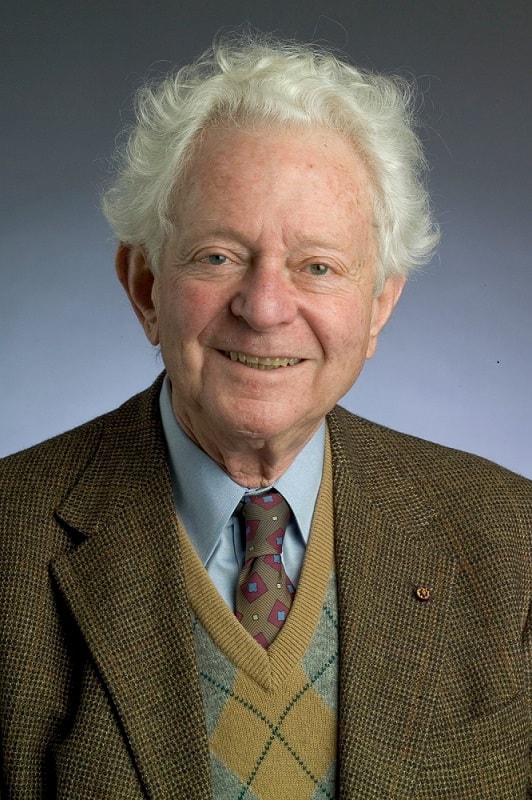Nobel laureate Leon Lederman dies aged 96
04 Oct 2018 Michael Banks
Leon Lederman, the US particle physicist who shared the 1988 Nobel Prize for Physics with Melvin Schwartz and Jack Steinberger, died on 3 October aged 96. Lederman pioneered experiments at Brookhaven National Laboratory (BNL) in the early 1960s that led to the discovery of multiple types of neutrino. He also served as director of the Fermi National Accelerator Laboratory in Illinois.
Born in New York City on 15 July 1922, Lederman studied chemistry at City College New York graduating in 1943. After three years serving in the Second World War, Lederman was awarded a PhD in physics from Columbia University in 1951. He then remained at Columbia University until 1978 before succeeding Robert Wilson as head of Fermilab – a position he held until retiring in 1989.
Lederman made a number of pioneering contributions to particle physics, particularly neutrino physics. Neutrinos are particles with no electrical charge that interact very weakly with matter – making them extremely difficult to detect. Their existence was first predicted in 1930 by Wolfgang Pauli and first detected in 1956 when Frederick Reines and Clyde Cowan spotted electron antineutrinos emitted by a nuclear reactor, for which the pair went on to win the 1995 Nobel Prize for Physics.
[Lederman’s] leadership helped to shape the field of particle physics, designing, building and operating the Tevatron and positioning the laboratory to become a world leader in accelerator and neutrino scienceNigel Lockyer
In 1957 the Italian physicist Bruno Pontecorvo suggested that multiple types, or “flavours”, of neutrinos exist and that they can change, or “oscillate”, from one to another. That was confirmed in 1962 when Lederman – along with Schwartz and Steinberger – observed the existence of the muon neutrino in experiments using Brookhaven’s Alternating Gradient Synchrotron. This involved firing a beam of high-energy protons into a metal beryllium target. The resulting cascade of particles included muons – a heavier version of the electron – as well as neutrinos. A 13.5 m-thick steel wall was then used to remove all the particles except neutrinos, which were detected by watching the sparks created when the particles interacted very occasionally with the atoms in a ten-tonne aluminium detector.
Because the neutrino reactions in the detector only ever produced muons, rather than electrons, they concluded that neutrinos must come in at least two types – muon neutrinos and electron neutrinos. It was for this work that the trio shared the 1988 Nobel Prize for Physics. A third type of neutrino – the tau – was predicted in 1975 and discovered in 2000.
The “god particle”
The discovery of multiple types of neutrinos was not the only major contribution Lederman made to particle physics. In the 1950s he was part of a team working at the BNL that discovered the long-lived neutral K meson. As head of Fermilab, Lederman also led the team that discovered the bottom quark as well as headed the effort to build the Tevatron collider – which was the world’s highest energy particle collider from 1983 to 2010.
Lederman was also passionate about education and outreach. In 1985 he helped found the Illinois Math and Science Academy and as director of Fermilab he established the ongoing Saturday Morning Physics programme for students to learn more about particle physics. In 2008, he even set up a stall on the corner of 34th Street and 8th Avenue in New York City where he answered science questions from the public.
Lederman is also known for his 1993 book The God Particle: If the Universe Is the Answer, What Is the Question?, in which he attempted to rename the Higgs particle as the “God particle”. The term failed to convince particle physicists who stuck to the original name for the boson that was first discovered at CERN’s Large Hadron Collider in 2012.
Along with the Nobel prize, Lederman was awarded the 1965 National Medal of Science, the Wolf Prize for Physics in 1982, the Enrico Fermi Award in 1992 as well as the Vannevar Bush Award in 2012 for exceptional lifelong leaders in science and technology. In May 2015 Lederman’s Nobel Prize gold medal was sold at auction for $765 000 to help pay his medical bills following a diagnosis of dementia.READ MORE

“[Lederman’s] leadership helped to shape the field of particle physics, designing, building and operating the Tevatron and positioning the laboratory to become a world leader in accelerator and neutrino science,” says current Fermilab director Nigel Lockyer. “[He] had an immeasurable impact on the evolution of our laboratory and our commitment to future generations of scientists, and his legacy will live on in our daily work and our outreach efforts.”
10/10/2018 from physicsworld.com


Δεν υπάρχουν σχόλια:
Δημοσίευση σχολίου